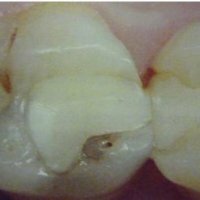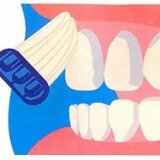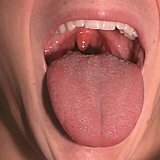Temporary filling with arsenic

The seal is temporary - it is placed on the patient for a short time, when he first calls for treatment of caries that progresses, or pulpitis or dental canals.
The meaning of such a seal and for what it is put
It is not installed by chance, in any case it has a certain therapeutic function. Often a temporary seal is considered a medicine, since together with cement a medicinal tab is installed that helps to treat certain diseases.
Her term is set by the attending physician, it can be a duration up to a whole month. It is also worth noting that due to the widespread use of new materials, once a temporary seal is installed, food can be taken immediately after the procedure.
The tooth is transformed from a regular bone into an organism already alive, thanks to the presence of a dental nerve or pulp. Because of them, the tooth becomes sensitive and has a reaction to external and internal stimuli. And so the process of removing pulp is considered an operation. She is appointed under weighty circumstances, confirmed by medical indications, and only when the nerve can not be saved by any means.
Caries is one of the main causes of inflammation in the pulp, which already leads to removal. For this reason, it is very important not to start such a disease, and take the prevention as seriously as possible. The inflammation starts from the dentine( hard tissue) and goes to the pulp( softer tissue), causing edema of the dental tissues. And this causes a sensation of pain, since the nerve tissues are squeezed. This disease is called pulpitis. It must be urgently treated so that the initial stage was captured on time, and the possibility of preserving the nerve and tooth remained.
Well and if nevertheless it did not turn out to save a nerve, it is necessary to remove it - to make depulpirovanie. Recently, such an operation was very painful, it caused association with something very unpleasant. Simply dentists until recently were able to kill a nerve, however, to anesthetize this process for them did not represent an opportunity.
Nowadays depilation is done with modern methods using modern equipment. Begin the treatment with the fact that they clean the mouth and the teeth from the deposited food. Anesthesia is then used. As soon as it begins to act, the tooth cavity is cleared from the caries. After this, the nerve is opened and in many cases it is killed using arsenic. Thanks to him, not only nerve endings are killed, but also pulp tissue, and therefore the sensations of pain very quickly subside.
A dental treatment using arsenic in the tooth or another toxic substance that causes mummification, as well as necrosis of the pulp tissue, is called devitalization.
After placing arsenic in the tooth, a temporary seal is placed on top. It is attached for a short time, for about a period of several days, to diagnose or for the purpose of treatment. For example, if the dentist can not immediately determine whether the nerve is completely affected or if there are several of them in the tooth, in this case a temporary seal should be inserted. If after a while the pain in the tooth again made itself felt, then it is required to further examine the tooth and treat it.
If no unpleasant changes occur during the residence time of arsenic in the tooth, the temporary filling is removed and the pulp is painlessly removed. Further filling and the main treatment of the tooth pass already without any sensations of pain.
A temporary filling is also used in cases when it is necessary to fix a medicine so that after a time it is possible to extract it from a problem tooth. To be clear, a temporary seal is not considered to be one that disappears by itself after a while, but one that the doctor can easily take away only by himself.
Application of arsenic in dentistry is no longer very relevant, despite the fact that its use in treatment on the body does not adversely affect. However, arsenic, unfortunately, has a negative effect on dentin, and this plays a direct role in its gradual destruction. Therefore, modern dentists everywhere use a different method - anesthesia is used immediately and the removal of the problem pulp is carried out. And use arsenic only when the patient has an allergic reaction, or intolerance of the local effect of anesthesia.
Contraindications
Arsenic is contraindicated in dentistry for children, since it is impossible to calculate the amount of toxins that can kill a nerve so that the child's health does not cause harm.



